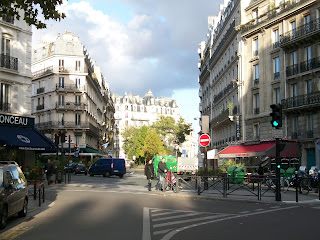I love the Paris Metro. I love its smell. I love its hallways. I love its design. I love its utility. My friend Denny Swanger calls it one of the wonders of the modern world. I'd be inclined to agree with that. When she was here over Christmas, my daughter remarked that she thought maybe most people in Paris took the Metro for granted, that in essence, they sort of put up with it. She's probably right (though like me, she's very fond of it!), but this is one of those rare cases where the people of Paris are wrong. The Metro is one of the world's great urban transport systems. No matter where you are in the city, you're seldom very far from a metro stop. Within a half hour, sometimes a little more, often less, you can be almost anywhere in the city.
The system is actually pretty old. The first line (still called "Line One") was built in 1900 for the World's Fair the city hosted that year. Paris has hosted a lot of world's fairs over the years (the Eiffel Tower was built for one of them). After that, it just continued to build more lines. Today it has sixteen different lines (two of which are branch lines to two other lines). The newest one, Line 14, was completed only a few years ago, and is the first fully automated line in the system--no driver.
I like the drivers, though. There's something cool about the fact that they often use large mirrors in each station to watch people get on and off so they'll know when to close the doors. The system is much higher tech than it used to be, with signs in each station now telling you when the next train is due, but those times have to be approximate because human beings drive the trains, and sometimes they speed up or slow down depending on the traffic.
And as the picture above shows, it's not all underground either. There are several lines that come up on top and are elevated for at least part of their run. One of those, line six, crosses the river offering a breathtaking view of the Eiffel Tower. Another, line two, travels north over the Canal St. Martin and crosses the tracks of two of the city's large railway stations. A third, line 5, crosses the river down from Notre Dame, and passes right *through* one of the city's large train stations.
One of the cooler things about the system is that it is always being updated. They're gradually building a beautiful new "light rail" system to ring round the city, hoping to get people off of the ring road, or Peripherique, which is often bumper to bumper with traffic. The second phase of this project, called Tram 3, will be completed in a couple of years, then they're planning a third. Likewise, they're always updating stations, and putting in new trains.
The system helps pay for itself with advertisements. I've seen the guys who paste these things up. They do it in large sections, and it's quite impressive the way they make sure each section matches perfectly so as to make it look like a single large photo. It's useful too. I can always tell which movies are opening soon because posters will go up in the metro a few weeks before.
One of the cooler things about the Metro are the ghost stations. Over the years, we've tried to spot them as the trains go by. The one above is the St. Martin station. Most of them were closed during the Second World War when use was down and then never reopened, usually because they were close to others and weren't needed anymore. Today they're covered in graffiti, but if you look close, you can still see the old ticket booths, ancient ads, and old signs. There are around seven of them, and metro fanatics like me like to "collect" them!
I ride the metro every day, and every day I see different faces in this amazingly diverse city. Of course, today, people are mostly messing with their ipods or talking on their cell phones, but there are still a good number reading novels and newspapers. France is a reading kind of country. Where else would a driver come on the intercom and apologize for a temporary delay because the train in front hasn't quite left the station yet? I love the metro.


















































